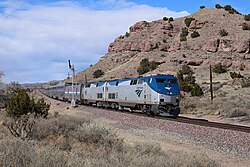
Back Хуткасны цягнік Byelorussian উচ্চতর-গতির রেল Bengali/Bangla Línea de altas prestaciones Spanish Kereta semi cepat ID 高速化 (鉄道) Japanese Ātrgaitas vilciens Latvian/Lettish Linha de altas prestações Portuguese Скоростной поезд Russian Yüksek standartlı demiryolu Turkish
Higher-speed rail (HrSR),[1] also known as high-performance rail,[2] higher-performance rail,[3] semi-high-speed rail or almost-high-speed rail,[4] is the jargon used to describe inter-city passenger rail services that have top speeds of more than conventional rail but are not high enough to be called high-speed rail services.[5] The term is also used by planners to identify the incremental rail improvements to increase train speeds and reduce travel time as alternatives to larger efforts to create or expand the high-speed rail networks.[6]
Though the definition of higher-speed rail varies from country to country, most countries refer to rail services operating at speeds up to 200 km/h (125 mph).[7]
The concept is usually viewed as stemming from efforts to upgrade a legacy railway line to high speed railway standards (speeds in excess of 250 km/h or 155 mph), but usually falling short on the intended speeds. The faster speeds are achieved through various means including new rolling stock such as tilting trains, upgrades to tracks including shallower curves, electrification, in-cab signalling, and less frequent halts/stops.[8]
- ^ Bowen, Douglas John (27 August 2012). "U.S. HSR accelerates". Railway Age. Archived from the original on 1 October 2012. Retrieved 10 October 2012.
- ^ "H.R.4361 – National High Performance Passenger Rail Transportation-Oriented Development Act of 2012[permanent dead link]" 112th Congress of the United States. Retrieved 10 September 2013.
- ^ Clayton, Mark (21 August 2012). "Obama plan for high-speed rail, after hitting a bump, chugs forward again". Christian Science Monitor. Archived from the original on 9 October 2012. Retrieved 10 October 2012.
- ^ [1] [dead link]
- ^ Cite error: The named reference
Borgeswas invoked but never defined (see the help page). - ^ Safety of High Speed Ground Transportation Systems (PDF) (Report). Federal Railroad Administration. December 1994. Archived (PDF) from the original on 3 March 2016. Retrieved 3 July 2014.
- ^ Cite error: The named reference
indiawas invoked but never defined (see the help page). - ^ "India-China to collaborate on building semi-high speed rail". The Economic Times. 29 March 2014. Archived from the original on 27 July 2014. Retrieved 4 July 2014.


